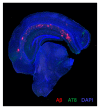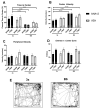rTMS Modulation of Behavioral and Biological Measures in 3xTg-AD Mice
- PMID: 39766385
- PMCID: PMC11674534
- DOI: 10.3390/brainsci14121186
rTMS Modulation of Behavioral and Biological Measures in 3xTg-AD Mice
Abstract
Background/objectives: The biological basis for behavioral manifestations of Alzheimer's disease remains unclear. Emotional and behavioral alterations of Alzheimer's disease can result in substantial caregiver burden and lack effective management. This study expands upon previous work investigating behavioral alterations in mice with Alzheimer's disease and a potential treatment of increasing brain-derived neurotrophic factor (BDNF) using repetitive transcranial magnetic stimulation (rTMS).
Methods: A total of 47 3xTg-AD (Alzheimer's) and 53 B6 (wildtype) mice were administered ANA12 (an antagonist of TrkB receptor) or Vehicle (saline) and then rTMS or Sham treatment daily. After 14 days of treatments and injections, mouse behavior was assessed under various behavioral cognitive tests. Mice were then perfused, and brain samples were processed for histology and protein assays. Brain homogenates were analyzed for BDNF and its downstream signaling molecules.
Results: Open field testing demonstrated that 3xTg-AD mice spent more time in the center than B6 mice. 3xTg-AD-Sham mice injected with ANA12 were the only group to travel significantly less distance than B6-ANA12-Sham or B6-Vehicle-Sham mice (p < 0.05), while 3xTg-AD-rTMS mice (irrespective of injection) were not significantly different from B6 mice. 3xTg-AD mice had significantly greater measured levels of BDNF and TrkB than the wild-type mice.
Conclusions: Treatment of Alzheimer's disease using rTMS positively affects elements of hypoactivity, but not all behavioral abnormalities. rTMS shifted 3xTg-AD open field behavioral test measures, generating significant differences between untreated 3xTg-AD and B6 genotypes. Despite its benefit, further investigation of rTMS as a treatment for Alzheimer's disease as well as its biological underpinnings are needed.
Keywords: ANA12; Alzheimer’s disease; disinhibition-like behavior; rTMS.
Conflict of interest statement
The authors declare that they have no known financial interests or personal relationships that could have appeared to influence this work. The views expressed in this article are those of the authors and do not necessarily reflect the position or policy of the Department of Veterans Affairs or the United States Government.
Figures




Similar articles
-
Memory-related hippocampal brain-derived neurotrophic factor activation pathways from repetitive transcranial magnetic stimulation in the 3xTg-AD mouse line.Exp Gerontol. 2023 Nov;183:112323. doi: 10.1016/j.exger.2023.112323. Epub 2023 Nov 1. Exp Gerontol. 2023. PMID: 39351497 Free PMC article.
-
High frequency repetitive transcranial magnetic stimulation alleviates cognitive deficits in 3xTg-AD mice by modulating the PI3K/Akt/GLT-1 axis.Redox Biol. 2022 Aug;54:102354. doi: 10.1016/j.redox.2022.102354. Epub 2022 May 30. Redox Biol. 2022. PMID: 35660628 Free PMC article.
-
Intermittent Hypoxia Training Prevents Deficient Learning-Memory Behavior in Mice Modeling Alzheimer's Disease: A Pilot Study.Front Aging Neurosci. 2021 Jul 1;13:674688. doi: 10.3389/fnagi.2021.674688. eCollection 2021. Front Aging Neurosci. 2021. PMID: 34276338 Free PMC article.
-
Alcohol drinking exacerbates neural and behavioral pathology in the 3xTg-AD mouse model of Alzheimer's disease.Int Rev Neurobiol. 2019;148:169-230. doi: 10.1016/bs.irn.2019.10.017. Epub 2019 Oct 23. Int Rev Neurobiol. 2019. PMID: 31733664 Free PMC article. Review.
-
The role of repetitive transcranial magnetic stimulation (rTMS) in the treatment of cognitive impairment in patients with Alzheimer's disease: A systematic review and meta-analysis.J Neurol Sci. 2019 Mar 15;398:184-191. doi: 10.1016/j.jns.2019.01.038. Epub 2019 Jan 24. J Neurol Sci. 2019. PMID: 30735817
Cited by
-
Advancement in modeling of Alzheimer's disease: a comprehensive review of preclinical screening platforms.Front Aging Neurosci. 2025 Aug 6;17:1646551. doi: 10.3389/fnagi.2025.1646551. eCollection 2025. Front Aging Neurosci. 2025. PMID: 40842652 Free PMC article. Review.
References
-
- CDC About Alzheimer’s. Alzheimer’s Disease and Dementia. Published 15 August 2024. [(accessed on 22 November 2024)]; Available online: https://www.cdc.gov/alzheimers-dementia/about/alzheimers.html.
Grants and funding
LinkOut - more resources
Full Text Sources

